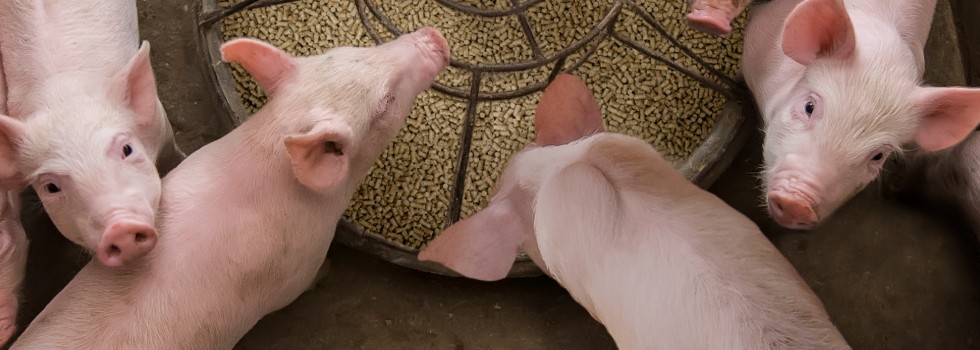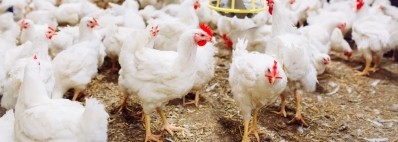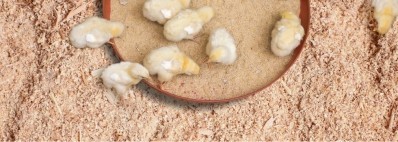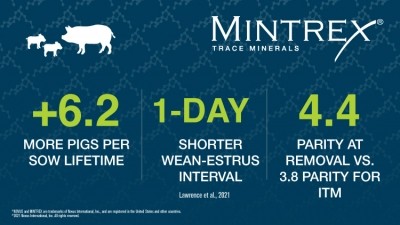Promotional Features
Zero zinc oxide: holistic approaches to manage piglet gut health challenges
Zero zinc oxide: holistic approaches to manage piglet gut health challenges
By Roberto Barea, Technical Services Manager – Swine, Novus International, Inc.
In recent decades, high levels of zinc oxide have been added to the post-weaning piglet’s diet to help manage gut disorders and performance losses. It is well accepted that including 2,000 to 3,000ppm of zinc oxide in the diet during the two weeks post-weaning can assist in reducing diarrhea occurrence and supporting piglet growth. However, high dietary zinc oxide levels can drastically alter the bacterial composition and development of certain microbiota in weaned piglets. Zinc oxide in the intestine has been shown to decrease the amount of lactobacilli, increase Clostridium Spp. and stabilize E. coli populations rather than reduce them. Other negative side-effects of applying zinc oxide in high doses include antibiotic resistance, development of multi-resistant E. coli strains, reduced absorption of other minerals, decreased activity of phytase enzymes and negative environmental impact due to high excretion of zinc. For these many reasons, medicinal doses of zinc oxide will no longer be authorized in the European Union beginning June 2022. This change is further complicated by the ongoing pressure to reduce antibiotic use in animal production and restrictions in the prophylactic use of antibiotics. As such, the industry is seeking suitable nutritional solutions to fit their piglet gut health program aimed at improving piglet health and productivity gradually without the use of zinc oxide.
The swine industry has a necessity to redesign post-weaning diets and management. Table 1 summarizes the diverse non-feed and feed-related strategies for zinc oxide replacement (Pluske, 2013; Bonetti et al., 2021; Huting et al., 2021). The approach needs to be holistic – addressing in a comprehensive way different aspects of the challenges and the diet.
Role of early nutrition and post-weaning feeding strategies on piglet development and gut health
The main goals of an early piglet nutrition program are to avoid post-weaning growth depression while helping piglets to adapt to a grain-based diet. It is important to make this transition as rapidly as possible. Phase feeding aims to make transitioning from one feed to another easier on the piglets’ gastrointestinal tract. Increasing feed intake during the first week post-weaning not only promotes growth and overall health during the nursery phase, but it also can positively impact performance during the pig’s entire production cycle (Villela, 2016). The nutritional interventions during this critical period should include supplementation of 1) highly digestible and palatable ingredients; 2) coarse particle size and reduced buffering capacity of the feed (e.g., by means of a proper inclusion of feedstuffs, minerals and organic acids) for better absorption in the stomach and intestine; 3) a low fermentable to inert fiber ratio; and 4) low dietary crude protein content to reduce protein fermentation and intestinal microbiota dysbiosis (Huting et al., 2021).
Research literature (Bonetti et al., 2021; Huting et al., 2021) shows that diets low in crude protein (16% instead of 20% crude protein) during the first weeks after weaning can reduce up to 30% the daily treatments against diarrhea, and also induce lower contents of proinflammatory cytokines (i.e., IL-1, TNF-α, IL-2, IL-6) and higher levels of anti-inflammatory cytokines (i.e., IL-10 and IL-13) in the colonic mucosa, which can improve gut integrity and epithelial functions in the piglet.
Research also shows that inert fiber such as insoluble non-starch polysaccharides (iNSP) can reduce fecal pathogens counts like that of enterotoxigenic E. coli, increasing the production of short-chain fatty acids in the intestine. Actually, iNSP are shown to reduce both the adhesion of pathogens to intestinal epithelial cells and decrease the transit time of digesta in the gut (Bonetti et al., 2021; Huting et al., 2021).
Immune development in the young pig
The piglet’s immune system matures in distinct phases within the first six or seven weeks of life. This development requires specific stimulatory inputs, which are primarily regulated by bioactive components of sow’s colostrum and milk. Weaning occurs during a critical immune period, when passive immune protection from the sow is declining and the piglet’s active immune system is not yet fully functional. In the gut, the development of the mucosal immune system coincides with the colonization of commensal and pathogenic microflora. The simultaneous development of the ability to mount an immune response and the ability to control and regulate such a response is required to optimize immune competence in piglets. Nutrition is a tool that can be exploited to assist the immune and digestive maturity of the young pig and provide aid in the weaning transition. The conventional view of nutrition simply supplying nutrients for maintenance and growth is a thing of the past and immuno-nutrition is rapidly gaining attention. An example of this is provided by functional proteins (e.g., like the immunoglobulin provided by spray-dried plasma), which can improve the immune system of weaning pigs. Other nutrients that can support piglet immunocompetence are trace minerals (i.e., zinc, iron, copper and selenium), which are involved in the regulation of the piglet’s immune system. These minerals also have an essential role against oxidative stress, in the integrity of tissues, and bone formation and the maintenance of skeletal integrity (Rucker et al., 1998; Garait, 2006).
The role of organic acids and trace minerals
Finding alternatives to zinc oxide for post-weaning piglets requires innovative combinations of several strategies to act synergistically and combining different modes of action. Functional feed additives (i.e., pre- and probiotics, organic acids, trace minerals, etc.) are a tool but are not a ‘silver bullet’ to replace zinc oxide. Organic acids are one of the most employed groups of feed additives in pig nutrition. In their classic role as acidifiers they can efficiently reduce gastric pH in weaning piglets, counteracting the buffering capacity of the diet, ensuring a proper digestion of dietary proteins, and serving to help control pathogens in the feed. Unfortunately, the need to be released in the gut limits the antibacterial efficacy of organic acids in lower parts of the intestine. Protecting organic acids in a fat matrix can secure their release in more distal parts of the gastrointestinal tract, enhancing antimicrobial activity (Barea et al., 2020).
New research (Correa et al., 2021) led by Novus International, Inc. in collaboration with the Complutense University of Madrid (Spain) and the University of Bologna (Italy), using metagenomic sequencing, a next-generation sequencing technology to study gut microbial modulation, found that dietary supplementation of protected benzoic acid (PROVENIA feed supplement, Novus International, Inc.) in piglet diets during the post-weaning period positively influenced the microbial profile compared to pharmacological doses of zinc oxide. Researchers believe the mode of action seems to be related to the increase in alpha diversity (e.g., measurement of species diversity in an ecosystem), which is considered a positive modulation parameter of the intestinal microflora. In addition, the protected benzoic acid favored the proliferation of certain bacterial genera such as Ruminococcus, Prevotella and Fibrobacter, involved in the fermentation of dietary polysaccharides and the production of short chain fatty acids, such as butyric acid, which are known to exert beneficial function for the host, providing energy to epithelial cells and inducing cell differentiation, intestinal immune modulation and enteric pathogen control.
Where weaning piglets are concerned, there has been increasing interest in the role of organic sources of trace minerals (e.g., chelates or complexes). Bis-chelated trace minerals are shown to be more bioavailable than complexes (i.e., glycinates, proteinates, etc.) as the mineral is protected from antagonisms in the gastrointestinal tract (Zhao et al., 2009; Richards, 2010; Liu et al., 2013; Barea et al., 2019). In the case of the copper bis-chelate bound with methionine hydroxy analogue (creating mineral methionine hydroxy analogue chelate; MINTREX Cu, Novus International, Inc.), an improvement of metabolic utilization resulting in enhanced performance responses and less excretion into the environment has also been shown (Ma et al., 2015;Gonzalez-Esquerra et al. 2019). Recent studies have also found that MINTREX Cu is a highly bioavailable source of chelated copper and provides positive results in terms of feed conversion, diarrhea and growth rate, reduction in the number of runts, and the decrease in mortality compared with other copper sources (Barea et al., 2017; Carpenter et al., 2017; Ren et al., 2020, 2021).
Conclusion
Finding innovative alternatives to pharmacological zinc oxide for weaning pigs will require combining several of the strategies and tools presented across this article to complement their different modes of action and targets synergistically. Moreover, a deeper knowledge of the post-weaning challenges and how they are interconnected is required for proper management during the rearing period. That understanding together with animal welfare improvements, biosecurity measures and nutritional strategies create a holistic approach.
Table 1. Different non-feed and feed related strategies for zinc oxide replacement in post-weaning piglets.
Husbandry/management techniques | Advantages | Disadvantages |
Farm biosecurity and environmental management | Better animal health, welfare and productivity | Labour organization, economic investment |
Colostrum quality and intake | Piglet survival, better lifetime performance | Increased number of piglets per sow resulted in lower colostrum intake per piglet, Limited number of studies on benefits of oral supplementations |
Weaning age (e.g., up to 28 days of age) | Better animal health, production and welfare | Investment in barn space, sow farm management under pressure |
Vaccination protocols (e.g., in sows and piglets) | Important tool for disease control | Vaccine failure can have genetic, environmental or management causes |
Water quality and quantity | Better health, support of piglet metabolism | Cost and availability of quality water is an issue in many regions of the world |
Creep feeding | Alleviate weaning issues | Risk of economic loss in case it does not offer real benefits |
| ||
Dietary interventions | Advantages | Disadvantages |
Low protein diets | Decrease proteolytic bacteria population and pro-inflammatory cytokines production in the gut | Increased feeding costs to support limiting amino acids supply to avoid performance losses |
High inert fiber contents | Improve gut health, enhance SCFA production | Lack of comparative results vs. zinc oxide in bibliography |
Low buffering capacity of feed | Improve stomach functioning and gut health | Proper management of feedstuffs and minerals is needed |
Coarse particle size of ingredients | Proper stomach function, gradual transition of digesta from the stomach to the gut | Few studies on benefits in weaned piglets, possible nutrient digestibility reduction |
Use of functional proteins | Improve growth performance, decrease of pathogen bacteria and pro-inflammatory cytokines in the gut | Lack of comparative results vs. zinc oxide in bibliography, higher feed costs, potential presence of pathogens (e.g., in spray-dried plasma) |
Organic acids | Reduction of gastric pH, increase of nutrient digestibility | Different activities between acids, low antibacterial efficacy in the gut if not in protected form |
Trace minerals | Essential role in the integrity of tissues (e.g., bone formation and maintenance of skeletal integrity), support immune function, oxidative stress reduction | Variable bioavailability of different sources, regulations on reduction of minerals in compound feed in several world regions, environmental impact due to mineral excretion |
Source: Pluske, 2013; Bonetti et al., 2021; Huting et al., 2021





